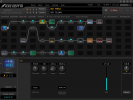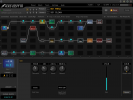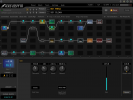It has defaulted to 1M as far as I can remember?
From the article...
3.1 Fuzz Face Input Impedance:
Is equal to the input impedance of a common emitter stage. It can be calculated as:
Zin = Zin of PNP Common Emitter = rπ
rπ=(β+1)⋅VtIEQ=(β+1)gm=(70+1)0.0088=8Krπ=(β+1)⋅VtIEQ=(β+1)gm=(70+1)0.0088=8K
For this math calculation the feedback network is ignored but in practice, it will lower the input impedance to 5KΩ approx. The Fuzz Face has a very low input impedance that will change with the position of the RFUZZ potentiometer (between 5.2KΩ and 8.4KΩ in the simulation). So the feedback network has a negative impact on this parameter.
As a rule of thumb, Zin should be at least 1 MΩ
. In other pedals with
similar input stages
like the one in the Big Muff Pi a series resistor is placed at the input in order to higher the impedance (at the cost of creating a voltage divider that reduces the available input signal).
The Fuzz Face low input impedance will load the guitar pickups. This is the reason why they do not respond well when they are placed after other pedals. A practical advice is to put your Fuzz Face first on the pedal chain, just after the guitar. The germanium transistor needs to see the inductance/impedance from the guitar pickups. If they see a buffer at the input, they tend to sound awful.



